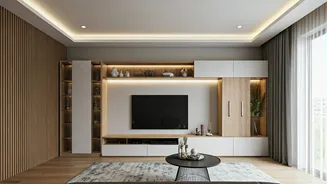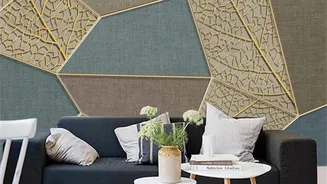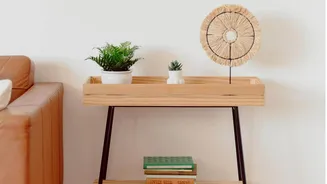Ceiling Design Basics
False ceilings are an excellent starting point for a living room makeover. They provide an opportunity to add depth, character, and improved lighting to your
space. Consider various materials such as gypsum, PVC, or wood, each offering different aesthetic and functional benefits. Gypsum ceilings, for instance, are versatile and can be molded into various shapes, while PVC offers durability and water resistance, and wood brings warmth and a classic touch. Think about recessed lighting or other creative lighting fixtures to enhance the overall ambiance. Also consider the practical aspects, such as soundproofing, as false ceilings can significantly reduce noise levels, creating a more peaceful living environment. There are design options from simple, clean lines to more elaborate patterns such as geometric shapes and ornamental designs. The choice depends on your personal style and the overall design scheme of your living room. Remember to consider the height of your ceiling and the size of your room when choosing a design, as some designs can make a room feel smaller.
TV Unit Considerations
The TV unit is a crucial element in modern living rooms, providing a focal point and integrating entertainment essentials. Simple TV unit designs can offer a clean, uncluttered look, while more complex designs incorporate storage and display areas. Think about the size of your TV and the available wall space when selecting a unit. Consider built-in units to maximize space or floating shelves for a minimalist aesthetic. Incorporating storage into your TV unit is practical for keeping your living room organized. Cabinets, drawers, and open shelves can store media equipment, books, and decorative items. Choose materials that complement your existing decor. Wood, glass, and metal are popular choices, each providing a different look and feel. The design of your TV unit should blend with the overall style of your living room, whether modern, traditional, or eclectic. Consider whether you'd prefer a unit that blends seamlessly with the wall or one that stands out as a statement piece. Also consider the position of the TV for comfortable viewing and the placement of power outlets and cable management systems to maintain a tidy look.
Cabinetry Design Ideas
Living room cabinets provide essential storage solutions, helping to maintain a tidy and organized space. The design of your cabinets can vary widely, from simple, minimalist styles to more elaborate, decorative options. Consider built-in cabinets for a seamless look, or modular units for flexibility. Think about the functionality of your cabinets. Consider the items you want to store, such as books, media, decorative items, and household essentials. Cabinets with drawers, shelves, and glass-front doors can offer a range of storage options. Choose materials that fit your budget and complement your interior design. Wood, MDF, and laminates are common materials, each with their own unique characteristics. The finish of your cabinets, whether painted, stained, or veneered, can significantly affect the overall look. Select hardware, such as handles, knobs, and hinges, that match your preferred style. Select a style that aligns with your living room's design scheme. Modern cabinets often feature clean lines and minimalist designs, while traditional cabinets might include more ornate details. The size and configuration of your cabinets should be appropriate for your space. Consider the dimensions of your living room and how the cabinets will fit in the overall layout, ensuring ease of movement and visual harmony.
Lighting Integration Tips
Lighting is key to setting the mood and enhancing the aesthetics of your living room. Consider the interplay of natural and artificial light. Large windows allow natural light to flood the space. Supplement this with artificial lighting for different functions. Recessed lighting provides general illumination, creating an even distribution of light throughout the room. Consider installing spotlights to highlight specific areas or features, such as artwork or architectural details. Choose pendant lights or chandeliers to create a focal point and add a touch of elegance. Install sconces for task lighting or ambient light, adding layers of depth. Think about the color temperature of your light bulbs. Warm white light creates a cozy atmosphere, while cool white light offers a more energizing feel. Consider dimmers to adjust the light intensity and create different moods. Also consider the placement of your lighting fixtures. Place lighting fixtures strategically to minimize shadows and create a well-balanced distribution of light throughout the room. Using smart lighting systems can enhance convenience and allow you to control your lights remotely, and set automated schedules.










